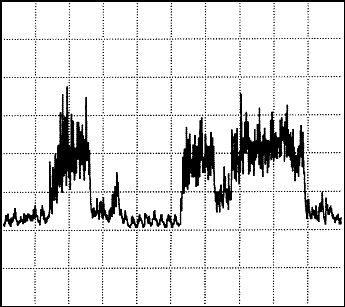
HERE IS BER LIN

HERE IS BER LIN
Ill. 19: OSCILLOGRAMS OF A PRECOGNITIVE DEAV (EXCERPT)
TOP: ORIGINAL - BOTTOM: RECTIFIED
SENKOWSKI Feb. 1st, 1977
INSTRUMENTAL TRANSCOMMUNICATION
by Ernst Senkowski
We up here all have a task.
The amount of equipment needed to conduct a full-scale analysis of speech- or speech-like signals is expensive and therefore not readily accessible to interested individuals, although the increased availability of efficient home computers in recent years has improved the situation to some extent. Official facilities are largely closed off to private individuals.
The identification of individuals by means of sophisticated speech recognition systems is not absolutely reliable. The opinion it were possible to ‘prove’ a deceased’s identity with a formerly living person by the ‘sameness of voice’ is basically wrong (and not only in this field!). Voice analyses can be of sense as an auxiliary means, at the most. Only very few official investigations of VOT have become known.
SOTSCHEK was the first who analysed for BENDER some voices that had been recorded at JUERGENSON under controlled conditions:
‘In 1964, the Institute of Freiburg in a first outset performed exploratory experiments to investigate the question whether the voice phenomena could be explained normally or were to be traced back to paranormal influences. A second investigation made in May 1970 with improved technical equipment made the paranormal origin of some of the voice phenomena very probable. Analyses of the phonations using the visible-speech method contributed essentially to objectify the understanding of their meaning.’
‘As early as in 1968, BENDER stated that the discovery of the voice phenomenon was presumably as important, if not more important, as the discovery of nuclear physics’ (BANDER 1972, p. 71).
A number of years ago, a US (military!) facility in the FRG requested VOT examples from the English experimenter CASS in order to analyse them with the most modern methods. The answer to an inquiry about these recordings was that they were not normal speech or terrestrial broadcasting. Despite of repeated reminders, the material was not returned (personal information).
The results of the examinations O’NEIL had made on the voice of TE Doc MUELLER, recorded with the Spiricom Mark IV system, induced a competent representative of BELL Laboratories to offer to MEEK, head of METASCIENCE, every kind of support. In an unqualified manner PETERSON alleged forgery in 1987, but in 1992 accepted the possibility of the existence of ‘genuine’ VOT and telephone contacts.
Italian electrical engineer CORRADINI (AISP) determined by oscillograph the concordance of the original voice of deceased Pope JOHANNES XXIII with a paranormal recording (personal information).
Upon order of ORSO, a comparison of the voices was made in Italy by applying the visible speech method. In the paranormal recording certain formants were missing from which the lack of a larynx was concluded. This observation confirms statements made by MACRAE (B-11.2).
STEUDEL reported about a comparison made at the Humboldt university of Berlin between a VOT he had received and the voice a deceased lady had had during her lifetime. The result of it was not unambiguous.
Giving his name, RAUDIVE presented himself with VOT examples on a record. During a VTF meeting in Fulda, and following the spontaneous request of a participant, manifested on KOENIG’s equipment a slowly speaking direct voice of deep tone with that same name. The author compared the two names. One cannot fail to hear the unison, to which an Eastern, Baltic accent contributes. Many RAUDIVE voice recordings of different experimenters bear a similar character.
Subjective voice recognition must not be underestimated. Under disturbed conditions the human being disposes of faculties of differentiation hardly obtained by technical arrangements as yet. However, reaching at the respective capacity limits, the person’s variables begin to take part increasingly. In telecommunication 75 % word comprehensibility are regarded as sufficient. The necessary S/N ratio (A-3) is achieved, partly even surpassed by good VOT/DEAV. Ill. 19 shows a fully understandable paranormal voice (S/N = 16 dB) audible from a loudspeaker. In such cases voice interpretation is unassailable. See also in B-12.3.
 HERE IS BER LIN |
 HERE IS BER LIN Ill. 19: OSCILLOGRAMS OF A PRECOGNITIVE DEAV (EXCERPT) TOP: ORIGINAL - BOTTOM: RECTIFIED SENKOWSKI Feb. 1st, 1977 |
During the last years, some experts in Italy and France have performed computer-aided electro-acoustical analyses of trans-voices, and undertook comparisons with the voices well-known deceased had during their lifetime.
Here shall be mentioned the studies made by the Italian engineer Daniele GULLÀ. Thanks to his relations to the University of Bologna, it is possible for him to work with most modern technical equipment and methods.
One of the first findings was the (frequent) missing of the basic frequencies that always exist in normal speech, fg, and the existence of ‘formants’, which do not appear as integral multiples of fg, but in a manner as if they were formed out of the noise. In the analyses and comparisons conducted with VOT (microphone, radio), telephone voices, and direct voices, the postmortem voice of a girl (recorded at BACCI in Grosseto) showed a high degree of resemblance of its characteristics with a recording made of her voice during her lifetime.
In France, engineer Gérard FERRANDI, among others, is active in analyzing paranormal voices. He, too, noticed the missing of the basic frequencies. FERRANDI is of the opinion that distinguishing between paranormal and normal is possible with a reliableness of 75 % to 100 % if a few characteristics are taken into consideration. The results can be found in the last years’ editions of the periodical “Parasciences & Transcommunication”.
back to TOP November 2004
|
You are visiting our website: W |